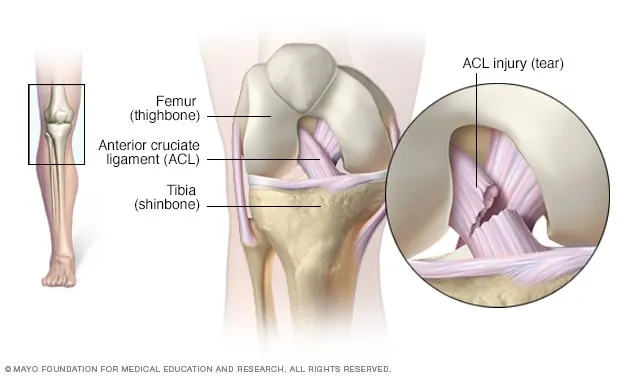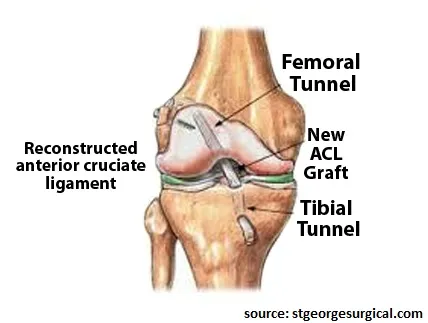ACL Reconstruction Treatment in Bhubaneswar
Are you feeling knee instability?
Do you feel that your knee is not as flexible as it used to be?
If yes, you should consult Dr. Sandeep Singh, the best ACL reconstruction doctor in Bhubaneswar. Dr Sandeep Singh, one of the best orthopedic doctor is also well-known for his experience and skills in ACL reconstruction surgeries.
Dr. Sandeep has a lot of experience and expertise in sports injury and joint replacement procedures. Years of experience have helped him gain a great deal of technical expertise in ACL reconstruction.
So, there is no doubt that you should approach Dr Sandeep Singh for an ACL reconstruction surgery in Bhubaneswar. Now let us discuss in detail about ACL and its reconstruction surgery. ACL stands for the knee’s Anterior Cruciate Ligament.
The knee is the body’s largest and most complicated joint. It relies on four main ligaments and several muscles, tendons, and secondary ligaments to work correctly.
TheACL is a ligament that attaches your thigh bone to your shin bone preventing the shin bone from slipping forward.
Why causes an ACL tear?
A direct hit to the knee usually occurs in football and is one of the most common ways for the ACL to be hurt. In this situation, the knee is twisted into an unnatural position, causing one or more knee ligaments to break.
However, most ACL tears actually occur without any contact between the knee and another object. These non-contact injuries occur when a runner switches course or hyperextends their knee when jumping from a leap. All agility sports have these movements.


What are the symptoms of an ACL tear?
When the ACL is broken, you can feel the knee gives way with an audible pop. A moderate level of pain is normally associated with the damage, and further exercise is usually impossible.
The knee swells up significantly over the next few hours, making walking impossible. Swelling and pain normally worsen over the first two days before gradually reducing.
However, if the pain does not decrease, you will find it challenging to maintain balance over the leg. Also, the knee “gives way” (buckles) while standing or pivoting over it.
If left untreated for a long time, the injured knee can lose strength and you might need a knee replacement. It is impossible to return to activities that include twisting and pivoting of the leg. An isolated long-standing ACL fracture could not cause any pain in the knee.
However, if there is some other structural damage or if there has been a long period of neglect, pain may increase. It’s not a good idea to ignore an ACL injury before the first signs of pain arise.
How is an ACL tear diagnosed?
However, some joint surface conditions are more challenging to detect. Swelling can also make diagnosing a tear difficult. This will require the use of an MRI scan to make a precise diagnosis.
When is it necessary to have ACL reconstruction surgery?
After an ACL injury, the most common question is, “Will I Require Surgery?” The response depends depending on who you ask. When deciding on the best course of action, you and your ACL reconstruction surgeon must consider several factors.
The factors to consider include:
- Your activity level and expectations
- The presence of associated injuries (meniscus and cartilage tears, etc.)
- Abnormal knee laxity
If a young patient with an ACL tear and knee laxity wishes to return to athletics or an active lifestyle, surgery is more likely to be required. An elderly patient who may return to limited activity is less likely to require surgery.
Exercises to help recover full range of motion continue knee healing in any scenario. It is followed by strengthening procedures for the muscles around the knee.
Only after leg mobility, balance, and coordination have returned to near-normal levels can you return to sports with or without a brace.
Long-term tests have found that a non-functioning ACL caused by a full tear leads to future joint damage. So early surgery to reconstruct a new ACL is the best treatment.
What is the procedure for ACL reconstruction?
For the ACL-injured knee, a variety of surgical approaches have been created. Years of experience have shown that just stitching the ligament together rarely works.
As a result, existing procedures include reconstructing the ACL by creating a new ligament from a tissue taken out from other tendons around the knee.
This tissue is passed into drill holes in the thigh and shin bones and then anchored in place with implants to produce a new ACL. This graft matures into a living ligament in your knee over time.

What happens after the surgery is completed?
After an ACL reconstruction, knee rehabilitation takes time and effort. The amount of time off you get depends on the kind of career you have:
- Employees who work at a desk will typically return after one to two weeks, while construction workers usually return after a month.
- After 4 to 6 months, athletes are eligible to participate in sports. Rehabilitation depends on the individual’s activity and recovery rate.
ACL surgery has a very high average success rate. According to several studies, over 98% of patients can return to sports and work without experiencing knee instability.
While certain patients experience stiffness and discomfort following surgery, new surgical procedures have reduced these issues.
Got Some Questions
After ACL Reconstruction
The success of ACL restoration is dependent on rehabilitation. You’ll be told to take painkillers, keep your incision clean and dry, and rest immediately after surgery. Icing your knee is very important since it relieves pain and reduces swelling. Within a few weeks of surgery, you’ll most likely have a follow-up appointment with your doctor or surgeon.
What Is The Success Rate Of ACL Surgery?
The success rate of ACL restoration surgery is 80-90 percent. However, this leaves a significant number of patients with disappointing outcomes. Knee instability or re-rupture of the ACL graft are considered to be responsible for 8% of the bad outcomes.
What Type Of Complications Can Occur With An Acl Reconstruction?
Missed recurrent injuries, tunnel malposition, patellar fracture, knee stiffness, and infection are all severe problems that can occur during ACL restoration. We look at the problems that can arise as a result of mistakes made before, during, or after surgery.
Because ACL reconstruction is a surgical treatment, there are also some risks involved with it, such as bleeding and blood clots. Knee pain continues. If the graft comes from a corpse, disease transmission is a possibility.
Why ACL Reconstruction Is Performed?
ACL reconstruction surgery is used to repair a torn ACL and restore knee stability and mobility. While not all cases of a torn ligament require surgery, those who are particularly active or who are in extreme pain may choose to have it done.
If you are young and active, you may benefit from ACL reconstruction. If you have recurrent knee discomfort, or if your injury causes your knee to buckle during everyday activities like walking, you may benefit from ACL repair.
Fill in the Form for Speedy
Appointment


